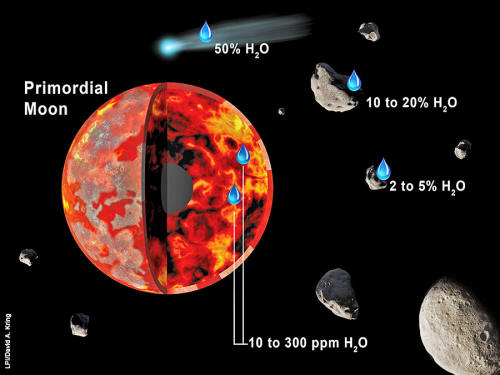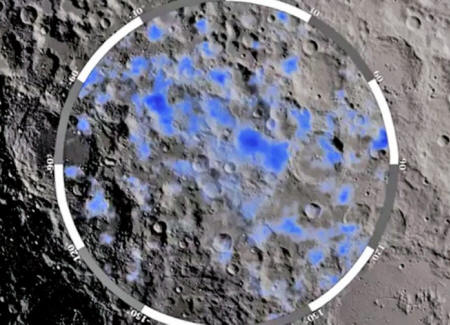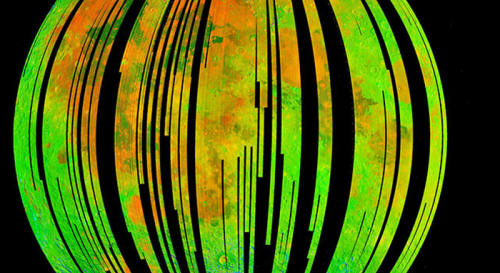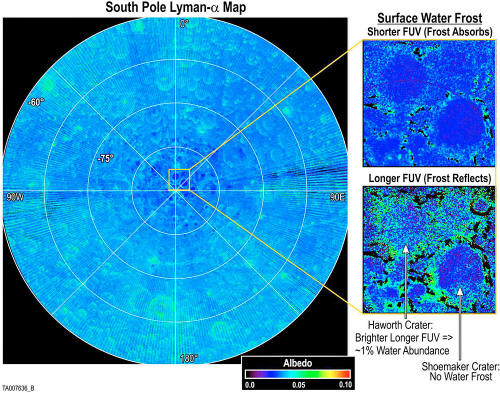|
from
UniverseToday Website asteroids delivered as much 80 percent of the Moon's water.
Credit: LPI/David A. Kring
Over the course of the past few decades, our ongoing exploration the Solar System has revealed some surprising discoveries.
For example, while we have yet to find life beyond our planet, we have discovered that the elements necessary for life, i.e.,
...are a lot more plentiful than previously thought.
In the 1960's, it was theorized that water ice could exist on the Moon; and by the next decade, sample return missions and probes were confirming this. Since that time, a great deal more water has been discovered, which has led to a debate within the scientific community as to where it all came from.
Was it the result of in-situ production, or was it delivered to the surface by water-bearing comets, asteroids and meteorites?
According to a recent study produced by a team of scientists from the UK, US and France, the majority of the Moon's water appears to have come from meteorites that delivered water to Earth and the Moon billions of years ago.
For the sake of their study (An Asteroidal Origin for Water in the Moon), which appeared recently in Nature Communications, the international research team examined the samples of lunar rock and soil that were returned by the Apollo missions.
When these samples were originally examined upon their return to Earth, it was assumed that the trace of amounts of water they contained were the result of contamination from Earth's atmosphere since the containers in which the Moon rocks were brought home weren't airtight.
The Moon, it was widely believed, was 'bone dry'...
The blue areas show locations on the Moon's south pole where water ice is likely to exist. Credit: NASA/GSFC
However, a 2008 study (Volatile Content of Lunar Volcanic Glasses and the Presence of Water in the Moon's Interior) revealed that the samples of volcanic glass beads contained water molecules (46 parts per million), as well as various volatile elements,
...that could not have been the result of contamination.
This was followed up by the deployment of the Lunar Reconnaissance Orbiter (LRO) and the Lunar Crater Observation and Sensing Satellite (LCROSS) in 2009, which discovered abundant supplies of water around the southern polar region.
However, that which was discovered on the surface paled in comparison the water that was discovered beneath it.
Evidence of water in the interior was first revealed by the ISRO's Chandrayaan-1 lunar orbiter - which carried the NASA's Moon Mineralogy Mapper (M3) and delivered it to the surface.
Analysis of this and other data has showed that water in the Moon's interior is up to a million times more abundant than what's on the surface.
The presence of so much water beneath the surface has begged the question,
Whereas water that exists on the Moon's surface in lunar regolith appears to be the result of interaction with solar wind, this cannot account for the abundant sources deep underground.
A previous report suggested that it came from Earth, as the leading theory for the Moon's formation is that a large Mars-sized body impacted our nascent planet about 4.5 billion years ago, and the resulting 'debris' formed the Moon.
The similarity between water isotopes on both bodies seems to support that theory.
Near-infrared image of the Moon's surface by NASA's Moon Mineralogy Mapper on the Indian Space Research Organization's Chandrayaan-1 mission. Credit: ISRO/NASA/JPL-Caltech/Brown Univ./USGS
However, according to Dr. David A. Kring, a member of the research team that was led by Jessica Barnes from Open University, this explanation can only account for about a quarter of the water inside the moon.
This, apparently, is due to the fact that most of the water would not have survived the processes involved in the formation of the Moon, and keep the same ratio of hydrogen isotopes.
Instead, Kring and his colleagues examined the possibility that water-bearing meteorites delivered water to both (hence the similar isotopes) after the Moon had formed.
As Dr. Kring told Universe Today via email:
By comparing the ratios of hydrogen to deuterium (aka. "heavy hydrogen") from the Apollo samples and known comets, they determined that a combination of primitive meteorites (carbonaceous chondrite-type) were responsible for the majority of water to be found in the Moon's interior today.
In addition, they concluded that these types of comets played an important role when it comes to the origins of water in the inner Solar System.
Images produced by the Lyman Alpha Mapping Project (LAMP) aboard NASA's Lunar Reconnaissance Orbiter reveal features at the Moon's northern and southern poles, as well as the presence of water frost. Credit: NASA/SwRI
For some time, scientists have argued that the abundance of water on Earth may be due in part to 'impacts' from comets, trans-Neptunian objects or water-rich meteoroids.
Here too, this was based on the fact that the ratio of the hydrogen isotopes (deuterium and protium) in asteroids like 67P/Churyumov-Gerasimenko (see '67P/Churyumov-Gerasimenko - A Jupiter Family Comet with a High D/H Ratio') revealed a similar percentage of impurities to carbon-rich chondrites that were found in the Earth's oceans.
But how much of Earth's water was delivered, how much was produced indigenously, and whether or not the Moon was formed with its water already there, have remained the subject of much scholarly debate.
Thank to this latest study, we may now have a better idea of how and when meteorites delivered water to both bodies, thus giving us a better understanding of the origins of water in the inner Solar System.
The existence of water on the Moon has always been a source of excitement, particularly to those who hope to see a lunar base established there someday.
By knowing the source of that water, we can also come to know more about the history of the Solar System and how it came to be.
It will also come in handy when it comes time to search for other sources of water, which will always be a factor when trying to establishing outposts and even colonies throughout the Solar System.
|





